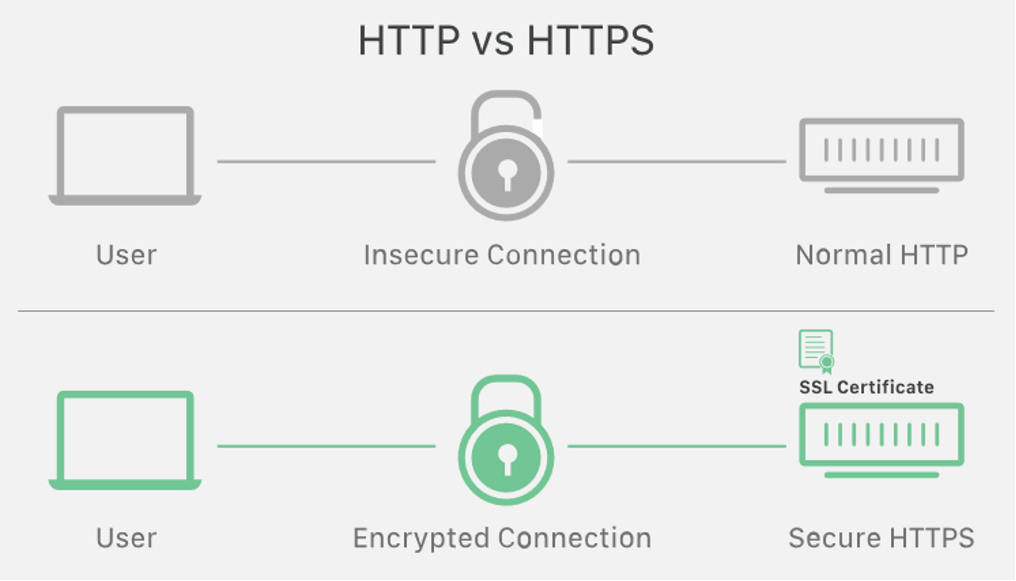Ads Interactive is an avid supporter of HTTPS and we always encourage our portfolio members to migrate to HTTPS. Some of the reasons are performance benefits, security, and SEO benefits. While we continue to use HTTP and HTTPS acronyms, it is equally important to understand the basics of how they work and the differences between them.

Http or https in a nutshell
HTTPS with an HTTP encryption. The difference between the two protocols is that HTTPS uses TLS (SSL) to encrypt normal HTTP requests and responses. As a result, HTTPS is much more secure than HTTP. Websites that use HTTP have HTTP: // in their URLs, and websites that use HTTPS include HTTPS: //.
What is HTTP?
HTTP stands for Hypertext Transfer Protocol. It is a protocol – or a prescribed sequence for displaying information – that is used to transmit data over a network. Most information sent over the Internet, including website content and API calls, uses the HTTP protocol.

There are two main types of HTTP messages: requests and responses. HTTP requests are generated by the user’s browser as the user interacts with web properties. For example, when a user clicks on a hyperlink, the browser sends a series of “HTTP GET” requests to the content displayed on the page. These HTTP requests go to an original server, and that server generates an HTTP response. HTTP responses are responses to HTTP requests.
HTTP requests and responses are sent as plain text over the Internet. The problem is that anyone watching the connection can read these simple texts. This is especially a problem when users submit sensitive data through a website or web application. This can be a password, a credit card number, or any other information you enter on a form. In essence, a malicious actor can only read the text in a request or response and know exactly what information someone is asking for, sending, or receiving, and can even manipulate communication.

The solution to the above security issue is HTTPS.
What is HTTPS?
HTTPS stands for Hypertext Transfer Protocol Secure HTTPS uses TLS (or SSL) to encrypt HTTP requests and responses, so that an attacker sees a series of characters that appear random instead of plain text.
TLS uses a technology called public key encryption: there are two keys, one public key and one private key. The public key is shared with client devices through the server’s SSL certificate. Certificates are cryptographically signed by a certification authority (CA), and each browser has a list of CAs that it implicitly trusts. Certificates signed by a trusted CA will have a green padlock in their browser’s address bar because they are proven to be “trusted” and belong to this domain.

When a client connects to a server, each machine needs a verified identity. All HTTP requests and responses are encrypted with session keys, so anyone who intercepts communication can see only a random string, not plain text.
In addition to encrypting communications, HTTPS is also used to authenticate the two communicating parties. Authentication is the verification that a person or machine is the person to whom it is claimed.

Just as an ID card confirms an identity, a private key confirms the identity of a server.
When a client opens a channel with an original server, having a private key that matches the public key in the site’s SSL certificate proves that the server is actually the legitimate host for the site. This prevents or helps block many of the attacks that are possible without authentication.
Important information for publishers
On Google search results pages, pages that do not have SSL are ranked lower, as may be affected by using an inconsistent URL structure without a www or www, and improper settings may result in duplicate content.
That’s why it’s important to have the right SSL and the right www / non-www setting to serve ads.
Interoperability between http / https and www / non-www causes an anomaly when consent is generated. Please note that after installing the SSL certificate, the page can only be accessed via https, and even with the selected www / non-www URL structure, only the selected version is available, in which case there is no interoperability.

The Ads Interactive development and IT team is available to all our partners to clarify and configure all of these.
Summary
HTTPS has many benefits, both in terms of performance and, most importantly, security. All browsers strongly encourage users to trust only those sites that use HTTPS, as this is the only measure that can help mitigate various threats and attacks.
Would you like to know more? Are you interested in increasing the revenue from your site? Contact us - we can help you!
If you're already a member, and you have a question, contact our Customer Success Team. We will help you!






